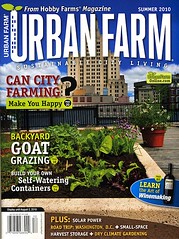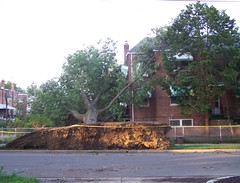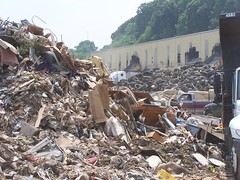Urban green follow up
There are so many urban green efforts that show the kind of evolved approach to environmentalism mentioned in the previously cited pieces from the Project for Public Spaces, including "Placemaking as a New Environmentalism: Reinvigorating the Environmental Movement in the 21st Century" and "Place Capital: The Shared Wealth that Drives Thriving Communities" that I didn't mention.
1. Washington City Paper has a nice piece on LEED-ND, "Easy Does It," where Lydia DePillis makes the point that I make all the time, that cities are green from an energy standpoint already and does a LEED certified building really help, if people still drive to it?
2. Urban agriculture is covered here all the time, but always worth re-mentioning. There is a publication from the people who do Hobby Farm, called Urban Farm.
Vertical gardening, community gardening, utilizing tree boxes, urban orchards, etc. are some of the things that people can do.

3. Baltimore has the great Urbanite Magazine and Philadelphia has the magazine Grid: Towards a Sustainable Philadelphia. Both focus their April editions on green/Earth Day related content.
4. One of the people I met at the "Life in the 20-Minute Neighborhood" workshop that was part of Baltimore's Green Week lives in the Patterson Park neighborhood in Baltimore. She told me that the community is developing a green master plan.
They have a charrette scheduled for May 14th. See the blog entry, "TL assists with Green Master Plan for Patterson Park" for more information. From the entry:
Topics discussed and ideas generated will include Transit – options, biking and walking!, Cleanliness – neighborhood-level trash reduction and appearance; Pollution Prevention – upstream and down, harvesting rainwater and Greening – beautification through environmental strategies & landscape. The GMP team will collate the responses from the charrette and incorporate them into the final Green Master Plan report which will be our roadmap for the future enabling us to be the cleanest, greenest and healthiest neighborhood in all of Baltimore!
More neighborhoods ought to take up similar initiatives.
-- Green Streets Strategy Discussed at Ecodistricts Summit, Portland, Oregon
-- DC Southwest Ecodistrict Initiative, next meeting is May 19th, 2011
5. I wish that instead of the summer youth employment program in DC, that they would convert a number of high schools to a cooperative education program that functioned on a year round basis, including summer employment for a longer period in the summer.
One of the things they could do is have an agriculture/horticulture program, utilizing the now decrepit greenhouses present at many of the city's high schools. Somewhere I remember a program involving high school aged youth growing plants which were then planted throughout their community as a beautification initiative.
6. The Financial Times had an article on the volunteerism benefits of community gardening and horticulture programs last week, "Dutch dig big society." From the article:
She is also chairman of the Leiden Schools Gardens, where volunteering is on an even bigger scale. Leiden’s Schools Gardens scheme began nearly 80 years ago. Twelve schools in the city participate and between them offer 625 little plots of ground in Leiden for cultivation by their Dutch schoolchildren, mostly aged between 10 and 12. By 2000, the school-plots were falling into disorder and the entire scheme needed a new grip.
Carla and her team provided it. They recruited 60 adult volunteers to help to perpetuate the school tradition. The role of the adults is to guide and instruct the children and encourage them to sow and grow the right crops. In 2004, the Leiden city authorities were considering closing the scheme altogether and abolishing the green plots. They reckoned without Carla and her team. They dressed up their young gardeners as anything from piglets to beetroots and demonstrated for their future, bringing 600 children to sing prearranged songs and influence the council. They succeeded and Carla is now chairman of a formal board with a budget of some £20,000 a year and a manager, Marian Kathmann, who studied botany at university.
7. DC (and many other cities) are not at the forefront of sustainability planning when it comes to developing citywide composting programs. Cities like Seattle and Toronto are best practice in this regard. Even NYC does some pretty good stuff.
8. And why not manage the urban forest for stewardship and income generation? If companies like Weyerhauser can manage their forests, why not cities? When trees come down, why can't they be either milled or set up to become firewood, instead of mulched or just thrown in the waste stream?

9. DC isn't motivated to manage its waste stream because we sell our trash to Fairfax County so that they can burn it up and generate energy in their cogeneration facility. Communities need to consider this when they take up this issue. Is it better to burn "waste," or to reduce-reuse-recycle? Can they be complementary practices?

Fort Totten Waste Transfer Station, outdoor yard.
10. As a historic preservationist, I am not necessarily "into" solar panels on pitched roofs, because they are discordant on old buildings. However, Premier Power is one of a number of companies (I think) that is now producing solar tiles that look like roof tiles.
Labels: green-environment-urban



1 Comments:
Курсы валют в банках Казахстана на сегодня и завтра -
Курс валют в Казахстане
Post a Comment
<< Home